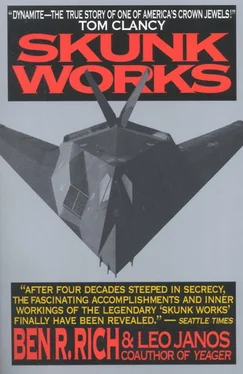One of the biggest cost items in defense is logistics management and maintenance. We should reevaluate the design of many components and make them throwaway or limited-shelf-life items. Batteries, brakes, servos, modular avionics, should all be replaced on a definite schedule, not wait for them to wear down. This would reduce the accumulation of large spare part inventories in city-size warehouses, cut down repairs and maintenance, and lower supply pipeline costs. Savings could run in the hundreds of millions.
One area in particular where the Skunk Works serves as a paragon for doing things right is aircraft maintenance. We have proven time and again that the Air Force would be much more efficient using civilian contractor maintenance on its air fleet whenever possible. Fifteen years ago, there were so many mechanical breakdowns on the flight lines at air bases around the world that it took three airplanes to keep just one flying. The reason: lack of good maintenance by inexperienced flight crews. We in the Skunk Works are the best in the business at providing our own ground crews to service and repair our own aircraft. For instance, two Air Force SR-71 Blackbirds based in England throughout the 1970s used Skunk Works maintenance. We had on hand a thirty-five-man crew. By contrast, two Air Force Blackbirds based at Kadena on Okinawa relied on only blue-suiter ground crews, which totaled six hundred personnel. Contractors can cross-train and keep personnel on site for years, whereas the military rotates people every three years, and valuable experience is lost.
Currently, two U-2s are stationed in Cyprus with twelve Lockheed maintenance persons, while two other U-2s stationed at Taif, in Saudi Arabia, in support of the UN mission in Iraq, have more than two hundred Air Force personnel. And when the U-2s at Taif need periodic overhauls, they are flown to Cyprus, where our crews do the job.
Another relatively easy cost-reduction scheme would be to rethink aircraft design so that all parts are “no-handed.” That is, there would be no left and right hinges or wing flaps or other control surfaces. The cockpit controls would likewise be no-handed. Production learning curves in manufacturing these items would be twice improved by not having to devote half to left and half to right and would reduce significantly spares and storage parts requirements.
Even at the Skunk Works I’ve seen my share of money wasted, at times in the most ridiculous ways imaginable. One that particularly sticks in my craw occurred when President Johnson first announced in 1964 the existence of the RS-71, the Air Force two-seater Blackbird. That’s right, RS-71 was its official designation, but Johnson accidentally turned it around and called it the “SR-71.” Instead of putting out a brief correction, the Air Force decided not to call attention to a very minor mistake by the commander in chief and ordered us to change about twenty-nine thousand blueprints and drawings at a cost of thousands of dollars so that they would read “SR-71” and not “RS-71.” Another frustrating example was the stubborn insistence of the Air Force to have its insignia painted on the wings and fuselage of the SR-71 Blackbird, even though no one would ever see it at eighty-five thousand feet; finding a way to keep the enamel from burning off under the enormous surface temperatures and maintain its true red, white, and blue colors took our chief chemist, Mel George, weeks of experimentation and cost the government thousands of unnecessary dollars. After we succeeded, the Air Force decided that the white on the emblem against the all-black fuselage was too easy to spot from the ground, so we repainted it pink. Air Force regulations also forced us to certify that the Blackbird could pass the Arizona road-dust test! Years earlier low-flying fighters training over Arizona’s desert wastes suffered engine damage from sand and grit. We had to demonstrate that our engine was specially coated to escape grit damage—this for an airplane that would overfly Arizona at sixteen miles high.
Such bureaucratic madness, I am certain, will never entirely disappear no matter how tight things get, but affordability nowadays is even more important than technology, and a genuine attempt to control costs is the highest priority among all branches of the military. The Skunk Works concept as a vibrant force in the American defense industry can come into its own only if and when the government reverses some of its counterproductive practices. And the most obvious place to start in achieving greater efficiency is to ferociously attack unnecessary bureaucratic red tape and paperwork.
I was in Boston recently and visited Old Ironsides at its berth, coincidentally at a time when the ship was being painted. I chatted with one of the supervisors and asked him about the length of the government specifications for this particular job. He said it numbered two hundred pages and laughed in embarrassment when I told him to take a look at the glass display case showing the original specification to build the ship in 1776, which was all of three pages.
Everyone in the defense industry knows that bureaucratic regulations, controls, and paperwork are at critical mass and, if unchecked, in danger of destroying the entire system. An Air Force general in procurement at the Pentagon once confided to me that his office handled thirty-three million pieces of paper every month—over one million per day. He admitted that there was no way his large office staff could begin to handle that kind of paper volume, much less read it. General Dynamics is forced by regulations to store ninety-two thousand boxes of data for their F-16 fighter program alone. They pay. rent on a fifty-thousand-square-foot warehouse, pay the salaries of employees to maintain, guard, and store these unread and useless boxes, and send the bill to the Air Force and you and me. That is just one fighter project. There are many other useless warehouses just like it. There is so much unnecessary red tape that by one estimate only 45 percent of a procurement budget actually is spent producing the hardware.
Oversight is vitally important, but we are being managed to death and constantly putting more funds and resources into the big end of the funnel to get an ever smaller trickle of useful output from the small end. Over the years in the Skunk Works, we supplied necessary paperwork when it was critically important and eliminated all the rest of it. A Skunk Works purchase order for vendor development of a system used in an advanced airplane took three pages. The vendor replied with a four-page letter proposal that included specifications for the system under development. And that was that. But at Lockheed’s main plant, or at any other manufacturer’s, that same transaction typically produced a 185-page purchase order, which led to a 1,200-page proposal, as well as three volumes on technical factors, costs, and management of the proposed project.
To put the paperwork blitz in perspective: there are currently operative throughout the Defense Department, acquisition regulations that reportedly could fill an entire shelf of 300-page books, in addition to 50,000 individual specifications, 12,000 contract clauses for specific components, 1,200 department directives, and 500 separate procurement regulations.
Paperwork should be limited to what the government most needs to keep tabs on. And I cannot deny that over the years the defense industry has had more than its share of cost overruns, bribery scandals, and other serious transgressions, which proves the need for intense scrutiny. In many ways, though, our sullied reputation was somewhat unearned because cost overruns in our industry were seldom more than 20 percent, while in other industries operating entirely by private financing, big-project overruns of 30 percent or even higher are not uncommon.
Читать дальше












